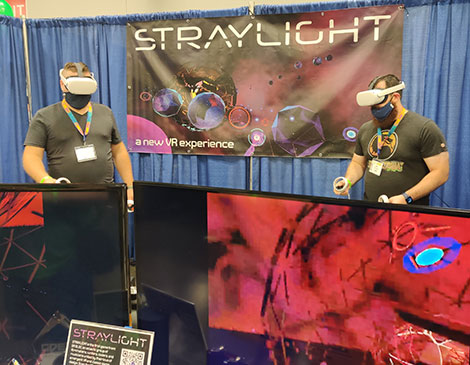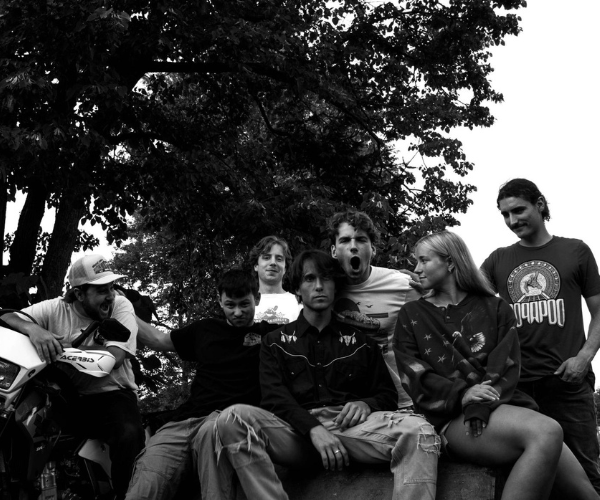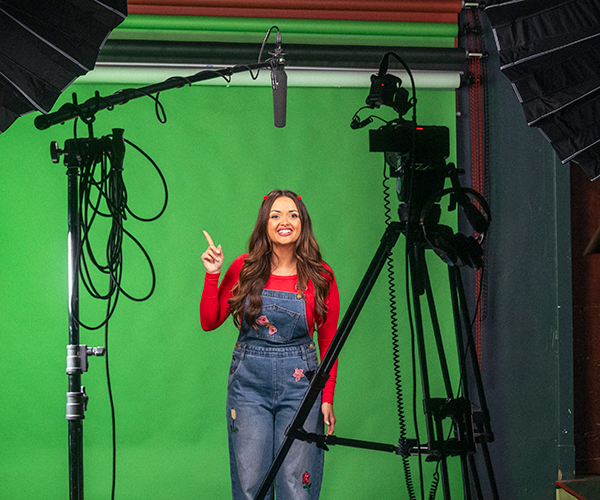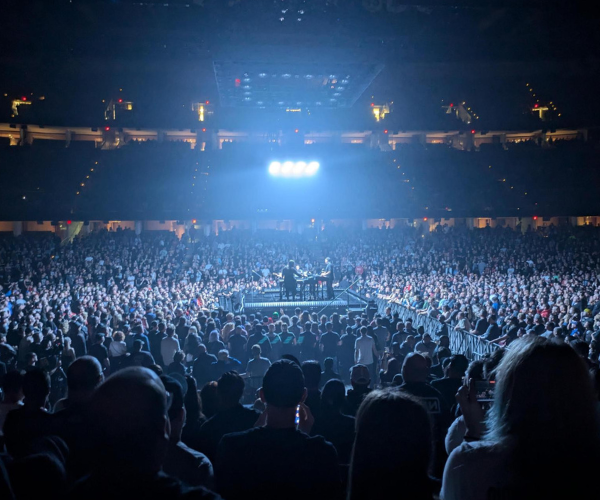Enter the world of Straylight, a bejeweled tour of unseen galaxies in which the player acts as a cyberpunk Spiderman.
Four and a half years ago Dr. Bloc’s first VR game was at its inception. In a hotel in Rocky River, two programmers, two film creators and a composer met for Global Game Jam in 2018. “They had just bought a VR headset right when they first came out and we all fell in love with it,” says Benjamin Barr, Straylight creative lead.
With dazzling energy and Rob “88bit” Kovacs’ hypnotizing soundtrack performed on a Sequential Prophet 5 synthesizer— and two GDEX Columbus gaming expo Best in Show trophies later— Straylight releases Jan. 31. The award-winning soundtrack—for which you can pledge a dark purple vinyl—releases Jan. 27.
Straylight ($19.99) is available for order on Steam, PSVR, Meta App Lab and SideQuest. It's compatible with most virtual reality headsets.
Cleveland Magazine probes the creative process with Barr and Kovacs.
Cleveland Magazine: What inspired Straylight’s aesthetic?
Benjamin Barr: The name comes from a pretty famous William Gibson novel called Neuromancer. At the beginning we thought we were going to try to go for this cyberpunk, retro-futuristic aesthetic. We ended up for some technical reasons going more abstract, but we still kept that purply, spacy, cybery look, which was also underlined by Rob’s score. We took a lot of inspiration from and tried to channel old-school, Nintendo, side scrolling, platforming games—Donkey Kongs and Super Mario Brothers—all that old stuff that we love.
CM: What are some of the old-school qualities you incorporated?
BB: Those old games tended to have one or two buttons. You only went in one direction. You could jump, maybe shoot a firewall. The goal was not complicated. The fun and complexity came from making it increasingly harder and harder to use those simple tools to get to the end of the goal. So that’s what we tried to do with this game. The only real point is to get to the end of each level using very simple tools, pulling yourself along with a grappling hook. But it gets harder and harder as we throw more and more fun stuff at you.
CM: What influenced Straylight’s sound?
Rob Kovacs: [In] a VR game where you can fly and repel and swing around in space… the idea of floating and something groundless. I was playing Petrushka by Stravinsky and there’s one section called “Dance of the Coachmen and Grooms." This big chord has this kind of weightlessness to it in anticipation. I used it as inspiration for the first song. This game is very new. When you play it, you’re seeing something you’ve never seen before. Musically it should reflect that. You should hear something that you’ve never heard before to give you the sense that you are in a totally new world.
CM: How does writing music for a video game differ from writing music for film?
RK: Movie scores always have characters in front and the music almost is always supporting that unless it’s a montage. But in video games you are the main character, you are creating the experience, so the music supports you. It can take a more present and focused presence in the game. There’s two main ways you can think of writing video game music. One is that the music changes and adapts to what the player does. That often requires it to loop for a certain while and then something new happens and you add a layer. We decided ultimately not to do that. Musically it’s very limiting.
CM: How does the soundtrack evolve with Straylight?
RK: Every level individually has one loop for the most part. Overall, from level to level to level, there is a sense of progression. The song’s going to get darker and more intense. So do the worlds, they get more massive and menacing. There’s definitely progression and an arc in the whole soundtrack.
CM: What’s the biggest challenge of designing a VR game?
BB: We sort of side-stepped that nausea issue. We figured out early on if we removed all the references and make everything abstract your brain doesn’t know where it is and it doesn’t get carsick. It presented a lot of really interesting design challenges because you can’t have boundaries around you in any normal sense. We had to figure out ways of keeping the player on the track that we want. How do we keep the game engaging and visually interesting when you can’t get too near anything that would feel like a wall or a floor? Finding a fun game within those constraints was a lot of fun but it was also difficult.
CM: Is VR the future of gaming?
BB: There’s a lot of itches video games scratch and VR only takes care of a very narrow band of that. I don’t think it will ever replace traditional video games. There’s just too many different kinds. Now, I do think that augmented reality, as soon as they can figure out how to do it in a glasses form, that’s going to change the world the same way that the iPhone did. But I think VR will always be a really cool boutique thing.
RK: VR is like the wild west of video games right now. In that sense, it’s very new and cutting edge, but VR has a lot of limitations. Video games outside of VR, there’s not really any technical limitations anymore like we had in the 8-bit and 16-bit era.
CM: What are the advantages and disadvantages to developing a game in Cleveland?
BB: Cleveland is still an incredibly inexpensive place for infrastructure and office space. There’s also a ton of talent. We see that at the game jams. There’s a lot of really talented young people here. On the other hand, there’s not a lot of tech infrastructure in a public-facing way like in some other more tech-focused towns to meet each other and collaborate, interface and liaison. I don’t see that as much in Cleveland, but I see it growing and I would love to see it grow even more.
RK: I think it’s really important if you’re in a smaller city like Cleveland to go to gaming conventions to get the attention of the other people in the industry. The stuff we create, it’s worth putting out there, we just have to do it.
Get ahead of the weekend by signing up for our free weekly “In the CLE” newsletter — your guide to fun throughout The Land. Arriving in your inbox every Wednesday, this weekend to-do list fills you in on everything from concerts to museum exhibits — and more. Click here to subscribe.




